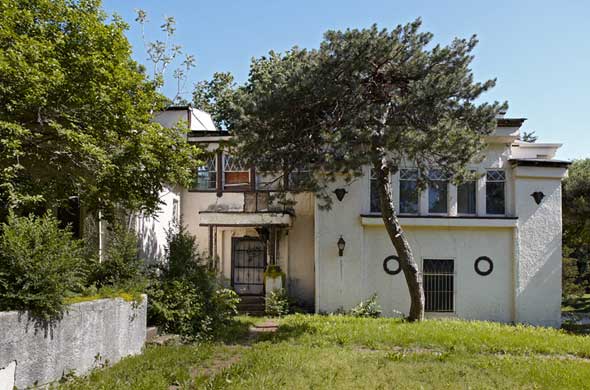(The Midtown KC Post is profiling the buildings on the Historic Kansas City Foundation’s Most Endangered List for 2013. More about our series of stories.)
By Joe Lambe
When Victor Beutner built his house in the Squire Park neighborhood in 1912, it was in a prosperous suburb.
His architect was Louis Curtiss, a master at his craft who wore all white, chain smoked and drove too fast.
That site at 1311 Manheim Road and blocks of old Squire Park homes that surround it now have national historic designation.
But the Beutner house is also on the city dangerous buildings list and on the Historic Kansas City Foundation list of 10 most endangered historic structures.
Curtiss designed it in the Prairie School style, mostly, and was in the best years of his career then, before World War I drastically reduced demand.
Later called “the Frank Lloyd Wright of Kansas City,” Curtiss was a Canadian-born architect who worked for most of his life in Kansas City.
He designed more than 200 buildings, including the Bernard Corrigan mansion at 55th Street and Ward Parkway.
The mansion also dates from 1912, uses reinforced concrete and incorporates elements of Prairie style, Frank Lloyd Wright and other styles.
Curtiss was also among the first to use glass-curtain wall design in 1908 with the six-story Boley Building at 12th and Walnut streets.
He also designed Downtown’s Folly Theater, still going strong, and the Hotel Baltimore, finished in 1899 and razed in 1939. He also did much work for newspaper boss William Rockhill Nelson and railroad and restaurant boss Fred Harvey, reports Professor Keith Eggener in an essay last year called “Louis Curtiss and the Politics of Architectural Reputation.”
Among Curtiss’ many memorable buildings, the Kansas City Public Library reports in a blog, is his studio and home designed in 1908 and still standing at 1118-20 McGee St.
He decorated there with bookcases and a pipe organ, the library said, and visitors told stories of a private entry from his apartment to a nearby vaudeville theater that hosted burlesque shows. No such entrance has been found.
Eggener, who teaches architectural history at the University of Missouri in Columbia, said little is known about Curtiss, but like Frank Lloyd Wright with his cape and cane and architect Bernard Maybeck with his smock and beret, Curtiss “styled himself a bohemian artist-aesthete.”
Accounts paint him as “a dandy bedecked in flashy all-white outfits and a pince-nez, chain smoking custom-made cigarettes that he ordered from a New York manufacturer in lots of 10,000.”
He was an early car enthusiast and “a notably fast and reckless driver.” Eggener wrote, a man prone to “grand pronouncements,” seances and Quija boards.
It all might have been affected to draw attention, he said, but if so it worked.
But Curtiss never married, rarely gave media interviews, published nothing about his work, and asked his personal papers be burned when he died.
He became reclusive toward the end, Eggener said, and in 1924 died alone at his drafting table at age 58.
Now he is in Mount Washington Cemetery, his grave unmarked, his career much less known than those of Wright and Maybeck.




Who’s talking